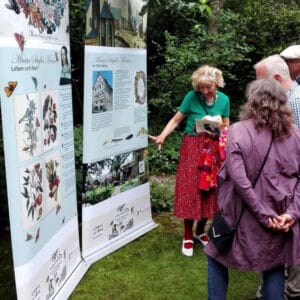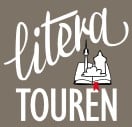Merian Oases
In 2013, during the refurbishment of Nuremberg Castle, the small garden next to the Imperial Chapel was named after Maria Sibylla Merian and redesigned with plant species found in her copperplate etchings. This made her better known and more popular in Nuremberg and its surroundings. In 2017, the tercentenary of her death, several exhibitions about her life and work aroused further interest, as did, for the first time in his home town of Nuremberg, one about her husband Johann Andreas Graff, an important pioneer of cityscape painting.
On the occasion of the commemorative year for Maria Sibylla Merian in 2017, the regional group of the Bund Naturschutz (Association for the Protection of Nature), together with the Merian School in Nuremberg, created a flower bed specifically to attract butterflies and insects in the “Heilkräutergarten” (Medicinal Herb Garden) at the Hallertor. This was the beginning of their co-operation with Margot and Dieter Lölhöffel, who have long been following in Maria Sibylla Merian's footsteps by highlighting the need to protect butterflies and by demanding more habitat for them.
One year later we saw the 350th anniversary of Maria Sibylla Merian’s arrival in Nuremberg; and we celebrated our own local jubilee year with some new initiatives, all in keeping with our own slogan: "MERIANIN 2018+ New Habitats for Insects".
The female ending “-in” on the surname, which was common for women in Nuremberg, Frankfurt and other cities at the time, was deliberately chosen as our brand logo. This makes our initiatives and especially our own website easier to find among the many other scientific and literary digital sources.
Right from the start of our activities, it was absolutely clear they would have to continue beyond 2018 in order to have a lasting impact. Therefore the little "+" became an important part of our motto because it points to the future.
Our ideas met with considerable support and the project “Merianin 2018+” began to grow. Since then we have distributed our own brochure comparing Merian’s research with the needs of bees, bugs and butterflies in the modern era.
We have developed a number of proposals designed to transform public parks, cemeteries, the outside areas around residential and office buildings, hitherto neglected waste ground, private gardens and even balconies into little pieces of Paradise for insects. Stefan Mümmler, who teaches on environmental issues, goes into schools with caterpillars and the appropriate equipment. Children observe the metamorphosis of the caterpillars and – after some weeks ‒ take the butterflies to the nearest meadow to release them and let them fly away.
Our very active Children’s Museum offers several programmes and project days which combine the urgent need to protect our environment with Merian’s exemplary work. Together we have produced three large roll-ups:
(1) Merian's life and work, contrasted to the roll-up with
(2) Facts and figures about Nuremberg during the time she and Graff lived here..
(3) The life and work of Johann Andreas Graff from Nuremberg are an important complementary theme.
We are always happy to lend out these roll-ups for workshops in schools, public events in garden centres or even in the Botanical Garden in Erlangen. These are just a few examples of the many activities taking place under the virtual patronage of Maria Sibylla Merian.
MERIAN AND NUREMBERG
She is growing increasingly popular in Nuremberg. Many of the people who live here already know that she was called “Frau Gräffin” [Mrs Graff] during her time in Nuremberg, but we prefer to call her “Merianin” in German and “Merian” in English because during her lifetime the female ending was usual in German but not in English-speaking countries. It is under this name that she is known across the world; indeed, she used it herself after her separation from her husband. People from very different social strata in Nuremberg (not only naturalists or art historians) are interested in knowing more about her and her local history in the second half of the 17th century, a period that up to now has been neglected in scholarly research on Nuremberg – as have her husband Johann Andreas Graff and his achievements.
In the last six years since 2018 it has become obvious that many people are more attentive to, and co-operative in fighting for, new solutions to the problems of our time if they find echoes in their own local history and can be proud of their own city’s past.
Numerous results of the research into Merian's life and work during her time in Nuremberg are documented on this website by means of texts, illustrations and bibliographical references. We hope this enables Merian's contribution to our cultural history here in Nuremberg to take root in our historical memory. This is an important precondition for ensuring both the continued success and the lasting effect of our initiatives.
In 1682 Merian returned to Frankfurt with her husband and daughters for family reasons, but her "Second Caterpillar Book" of 1683 was nonetheless printed in Nuremberg.
Her contact to Nuremberg remained alive in the following decades. Some of her letters have survived in museums and archives to this day and most of them are addressed to recipients in Nuremberg. This long-standing, successful relationship with Nuremberg should be sufficient cause for us to continue cultivating the memory of this world-famous artist and natural researcher in our city in years to come.
In the near future, starting in 2025 and within the short period of eight years after that, we shall witness the 350th anniversaries of the publication of her first six books in Nuremberg.
If you touch the title pages with your cursor, you will see the year in which we can celebrate the 350th anniversary of the publication of any one of Merian's books in Nuremberg. Please try it out
1675
First
Flower Book
2025
1678
Second
Flower Book
2028
1679
First
Caterpillar Book
2029
1680
Third
Flower Book
2030
1680
New
Flower Book
2030
1683
Second
Caterpillar Book
2033
In 1680, two new books were even published in the same year: the third part of the “Blumenbuch” and the “Neues Blumenbuch”. The latter was the complete edition, uniting all three flower books. Here she worked intensively and commenced her marvellous career with results, for which she is still world-famous today.
However, we are not merely concerned with the culture of memory: Merian’s research as the "first ecologist" is also ground-breaking for our present age with its grave environmental problems. With the support of Merian as our symbolic patroness we hope that many new flower meadows and colourful flower beds will be planted in Nuremberg and its surroundings as a home for insects, one where bees, butterflies and other insects find a rich choice of nutrition and gladly make their homes.
Our initiative wishes to make an enduring, inventive contribution to ensuring our continued enjoyment of the buzzing, fluttering creatures found in Merian’s fascinating copper prints, so that in future we may still marvel at them in the natural world.
VIRTUAL MONUMENTS ON THE NET
Not only in Nuremberg is criticism growing that there are far too few public memorials celebrating extraordinary women. Fierce arguments rage about where new monuments can be erected in public spaces and where streets can be named after women. However, in new suburban neighbourhoods on the edge of the city street names attract only scant public attention and suitable locations for monuments are hard to find. Moreover, design issues often lead to bitter, protracted disputes.
In Nuremberg, fortunate circumstances arising from the redesign of the “Nägeleinsplatz” (an area which used to boast many mills) in the northern part of the old town, coupled with the support of the city council, have resulted in the laying of a ”Merianin-Uferweg” (Merian Riverside Walk). Since 2022 it has formed part of a public park on the banks of the Pegnitz. Furthermore, with the increasing importance of the worldwide web virtual places of remembrance are becoming increasingly important. Therefore, the website www.merianin.de is conceived as a "living monument” into which new academic insights can be integrated in the future.
Video produced by Medienwerkstatt Franken since 2022
In collaboration with a scholar experienced in women’s history, Nadja Bennewitz, and other experts the Medienwerkstatt Franken has produced a video featuring women who played an important role in the history of Nuremberg at their corresponding locations in Nuremberg's old town. It goes under the title "Nürnbergerinnen zwischen Reformation und Frauenwahlrecht" (Nuremberg Women between the Reformation and Women's Suffrage). It was broadcast on 24 April and 1 May 2022 and can also be permanently viewed on the net as a " virtual memorial".
Merian is presented when the red dot on the timeline at the bottom of the video indicates minute 10:15. After an introduction with the fascinating music of the "Caterpillar Song” (Raupenlied), three locations are shown in the video, finishing at minute 17:25: the former family home at Bergstraße 10, the Maria Sibylla Merian Garden at the Imperial Castle and a desk in a study with a screen and the website www.merianin.de. Ms Bennewitz's interesting and comprehensive explanations, with their focus on "Fighting and Creating", do not agree in every detail with the research for this website, but this very fact makes it clear how complex Merian’s image remains, not only in historical novels but also in research, and where there is a need for further in-depth academic studies.

Margot Lölhöffel at her desk working on the Merian website
(Photo: Medienwerkstatt Franken)
Virtual Merian City Walk on the Worldwide Web since 2023
In a second offering the Stadtbibliothek Nürnberg (City Library Nuremberg) presents Merian in a new format: with the easily downloaded, free app "LiteraTouren“ from Google Play or the App Store, your own mobile phone can be used as an audio guide, because the information on our six signposts along the Merian Riverside Walk can be heard as audio texts in German and English, regardless of your location.
A view into the future
Merian’s research is also ground-breaking for both our present time and the future. With her as a symbolic “door-opener” we hope to succeed in arousing considerable interest in planting many new meadows and colourful flower beds in Nuremberg and its surroundings.
We have adapted our logo to reflect this new focus: instead of the year "2018+", the focus is now on efforts to create "oases" with new habitats for insects.
The prospects for success in the coming years are promising because the city of Nuremberg has been charged with designing and hosting the Bavarian State Garden Show 2030 and has chosen the motto "Urbane Gartenschau Nürnberg” (Urban Garden Exhibition Nuremberg).
It is hoped the "Merian Oases" initiative can contribute to creating synergies through its references to Merian's pioneering books from her time in Nuremberg and to Nuremberg as an exemplary garden city around 1700. Indeed, the planning and planting for the Bavarian State Garden Show must take place at some speed in the coming years. It is hard to imagine a more suitable virtual patroness than Merian for the “Landesgartenschau” 2030 in Nuremberg.
As the "first ecologist", Merian can make a special contribution to ensuring the success of this exhibition. Even more important is the fact that this garden show will provide long-term, sustainable impetus for a nature-orientated and climate-friendly transformation of our entire city, so that in future we can marvel once again at the buzzing, fluttering creatures found in Merian’s fascinating copper prints because we see them throughout Nuremberg’s natural world.

New logo representing our initiative from 2024 onwards; design: Theo Noll







